

No special process for running on the device (like provisional certificates or app stores)Ĭonnects directly to an HDTV via HDMI in up to 4k Have to write everything yourself, since you’re making your own app and not using an existing codebase like the Magic Mirror
#Magic mirror app install
Provisioning certificates that expire yearly to install on a device without going through the App Store
#Magic mirror app 1080p
Need a Lightning to HDMI adaptor that is limited to 1080p (until USB-C is common on iOS devices), which further increases the cost Very low maintenance, automatic updates, etc.Įxcellent development environment and debugging toolsīuilt in display and input (touch screen) for device setup, with automatic backups to make it easy to replace the device in the futureĪll configuration (device and application) can be done from a graphic interface, without resorting to editing configsĬost, especially for a new device, but used devices are quite affordable while still supporting the latest OS. iOSĪ complete device with a powerful processor and almost everything you need standard (except a built-in HDMI output) This is very much a “to each his own” thing. This assumes the Pi and Intel Compute Stick are running a Magic Mirror variant that uses a web browser and Apache or node.js server. Here’s my feelings on how an iOS device, a Raspberry Pi and an Intel Compute Stick running Windows compare for this purpose. If I put it on the App Store I can just download the update directly from the device. I don’t have to copy files over the network or onto an SD card or whatever. When I need to update the app, I can simply unplug the iPod touch and bring it up to my computer. And I don’t have to edit any configuration files to make it work. I also don’t need to have a keyboard and mouse somewhere for it, since I can just use the touch screen directly.
#Magic mirror app how to
Since I’m not running a browser, I don’t have to worry about cross-site API requests (although the newer node.js versions of the Magic Mirror don’t have that problem wither), I don’t have to deal with maintaining Apache or node.js on a machine, I don’t need to figure out how to get the rest of the normal desktop UI out of the way (like the mouse cursor or full screen mode), and so on.Īnother nice bonus is that the device’s screen can be used for configuration, and while the TV is only used for the mirror display.


Used Apple devices are easy to get, and older ones are quite affordable. Apple supports the latest version of iOS on fairly old devices. This seemed like a good first project.īeyond that, iOS is very mature, with easy to use, high level APIs and an excellent development environment. It mostly comes down to having iOS devices and wanting to learn iOS development. This app runs on a used seventh generation iPod Touch with a Lightning to HDMI adaptor that plugs into the TV.

My new smart mirror is built with SwiftUI on iOS 14. When that also failed, I decided to finally learn some iOS development and take an entirely different approach. The power supply on the TV died and needed to be replaced, I found linux on the Raspberry Pi difficult to use and replaced it with an Intel Compute Stick running Windows, and when that died another Atom-based compute stick. I had a few problems since the setup, mostly hardware related. I had previously built a Magic Mirror, which I’ve documented on this site.


 0 kommentar(er)
0 kommentar(er)
